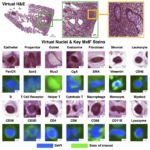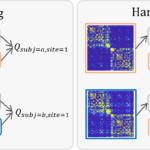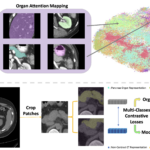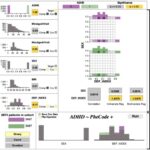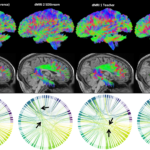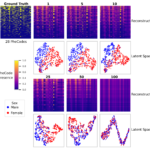Machine Learning Category
Field-of-view extension for brain diffusion MRI via deep generative models
Jul. 1, 2024—Chenyu Gao, Shunxing Bao, Michael E Kim, Nancy R Newlin, Praitayini Kanakaraj, Tianyuan Yao, Gaurav Rudravaram, Yuankai Huo, Daniel Moyer, Kurt Schilling, Walter A Kukull, Arthur W Toga, Derek B Archer, Timothy J Hohman, Bennett A Landman, Zhiyuan Li. “Field-of-view extension for brain diffusion MRI via deep generative models”. Journal of Medical Imaging 11 (4),...
Nucleus subtype classification using inter-modality learning
Dec. 19, 2023—Lucas W. Remedios, Shunxing Bao, Samuel W. Remedios, Ho Hin Lee, Leon Y. Cai, Thomas Li, Ruining Deng, Can Cui, Jia Li, Qi Liu, Ken S. Lau, Joseph T. Roland, Mary K. Washington, Lori A. Coburn, Keith T. Wilson, Yuankai Huo, Bennett A. Landman (2024). Nucleus subtype classification using inter-modality learning. SPIE Medical Imaging 2024 :...
Exploring shared memory architectures for end-to-end gigapixel deep learning
Dec. 19, 2023—Lucas W. Remedios, Leon Y. Cai, Samuel W. Remedios, Karthik Ramadass, Aravind Krishnan, Ruining Deng, Can Cui, Shunxing Bao, Lori A. Coburn, Yuankai Huo, Bennett A. Landman (2023). Exploring shared memory architectures for end-to-end gigapixel deep learning. MIDL 2023 short paper track Full text: NIHMSID Abstract Deep learning has made great strides in medical imaging, enabled by hardware advances in GPUs. One major constraint for the development...
Learning site-invariant features of connectomes to harmonize complex network measures
Dec. 1, 2023—Figure 1. Previous research elucidated that connectomes suffer from confounding site effects. In this work we propose a data-driven model to learn disjoint site (𝑐 = {1,2}) and biological features (siteless z) for BIOCARD (orange) and VMAP (blue) (left). We then inject a prescribed site, c’, to the learned representations to compute harmonized connectome modularity,...
Semantic-Aware Contrastive Learning for Multi-object Medical Image Segmentation
Aug. 31, 2023—Ho Hin Lee, Yucheng Tang, Qi Yang, Xin Yu, Leon Y. Cai, Lucas W. Remedios, Shunxing Bao, Bennett A. Landman, Yuankai Huo Paper: https://ieeexplore.ieee.org/document/10149329 Code: https://github.com/MASILab/DCC_CL Abstract Medical image segmentation, or computing voxel-wise semantic masks, is a fundamental yet challenging task in medical imaging domain. To increase the ability of encoder-decoder neural networks to perform this task...
UNesT: Local Spatial Representation Learning with Hierarchical Transformer for Efficient Medical Segmentation
Aug. 31, 2023—Xin Yu, Qi Yang, Yinchi Zhou, Leon Y. Cai , Riqiang Gao, Ho Hin Lee, Thomas Li, Shunxing Bao, Zhoubing Xu, Thomas A. Lasko, Richard G. Abramson, Zizhao Zhang, Yuankai Huo, Bennett A. Landman, Yucheng Tang Paper: https://arxiv.org/abs/2209.14378 Code: https://github.com/Project-MONAI/model-zoo/tree/dev/models Abstract Transformer-based models, capable of learning better global dependencies, have recently demonstrated exceptional repre- sentation learning capabilities...
pyPheWAS Explorer: a visualization tool for exploratory analysis of phenome-disease associations
Aug. 31, 2023—Cailey I. Kerley, Karthik Ramadass, Tin Q. Nguyen, Laurie E. Cutting, Bennett A. Landman, Matthew Berger Paper: https://pubmed.ncbi.nlm.nih.gov/37021295/ Code: https://github.com/MASILab/pyPheWAS Abstract Objective To enable interactive visualization of phenome-wide association studies (PheWAS) on electronic health records (EHR). Materials and Methods Current PheWAS technologies require familiarity with command-line interfaces and lack end-to-end data visualizations. pyPheWAS Explorer allows users to...
Convolutional-recurrent neural networks approximate diffusion tractography from T1-weighted MRI and associated anatomical context
May. 29, 2023—Leon Y. Cai, Ho Hin Lee, Nancy R. Newlin, Cailey I. Kerley, Praitayini Kanakaraj, Qi Yang, Graham W. Johnson, Daniel Moyer, Kurt G. Schilling, François Rheault, and Bennett A. Landman Paper: https://www.biorxiv.org/content/10.1101/2023.02.25.530046v2 Code: https://github.com/MASILab/cornn_tractography Abstract Diffusion MRI (dMRI) streamline tractography is the gold-standard for in vivo estimation of white matter (WM) pathways in the brain. However, the...
Extending the value of routine lung screening CT with quantitative body composition assessment
Nov. 28, 2022—Kaiwen Xu, Riqiang Gao, Yucheng Tang, Steve A. Deppen, Kim L. Sandler, Michael N. Kammer, Sanja L. Antic, Fabien Maldonado, Yuankai Huo, Mirza S. Khan, Bennett A. Landman Abstract Certain body composition phenotypes, like sarcopenia, are well established as predictive markers for post-surgery complications and overall survival of lung cancer patients. However, their association with...
Batch size: go big or go home? Counterintuitive improvement in medical autoencoders with smaller batch size
Nov. 13, 2022—Cailey I. Kerley*, Leon Y. Cai*, Yucheng Tang, Lori L. Beason-Held, Susan M. Resnick, Laurie E. Cutting, and Bennett A. Landman. *Equal first authorship Abstract Batch size is a key hyperparameter in training deep learning models. Conventional wisdom suggests larger batches produce improved model performance. Here we present evidence to the contrary, particularly when using autoencoders...

